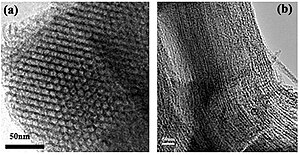MCM-41

MCM-41 (Mobil Composition of Matter No. 41) is a mesoporous material with a hierarchical structure from a family of silicate and alumosilicate solids that were first developed by researchers at Mobil Oil Corporation and that can be used as catalysts or catalyst supports.[2]
Structure[]
MCM-41 consists of a regular arrangement of cylindrical mesopores that form a one-dimensional pore system.[2] It is characterized by an independently adjustable pore diameter, a sharp pore distribution, a large surface and a large pore volume. The pores are larger than with zeolites and the pore distribution can easily be adjusted.[3] The mesopores have a diameter of 2 nm to 6.5 nm.
Properties[]
Contrary to zeolites, the framework of MCM-41 has no bronsted acid centers because there is no aluminium contained in the lattice. The acidity of alumina-doped MCM-41 therefore is comparable to that of the amorphous alumosilicates.[3]
MCM-41 is not hydrothermally stable because of the slight wall thickness and the low degree of cross-linking of the silicate units.[2]
Synthesis[]
To achieve a defined pore diameter surfactants are used that form micelles in the synthesis solution. These micelles form templates that help build up the mesoporous framework. For MCM-41 mostly cetyltrimethylammonium bromide (CTAB) is used.

The surfactant first forms rod-like micelles that subsequently align into hexagonal arrays. After adding silica species these cover the rods. Later, calcination leads to a condensation of the silanol groups so that the silicon atoms are bridged by oxygen atoms. The organic template is oxidized and disappears.
Uses[]
MCM-41, as the zeolites, are widely used as catalytic cracking.[4] They are also used for separations.
References[]
| Wikimedia Commons has media related to MCM-41. |
- ^ Guo, M.; Wang, H.; Huang, D.; Han, Z.; Li, Q.; Wang, X.; Chen, J. (2014). "Amperometric catechol biosensor based on laccase immobilized on nitrogen-doped ordered mesoporous carbon (N-OMC)/PVA matrix". Science and Technology of Advanced Materials. 15 (3): 035005. doi:10.1088/1468-6996/15/3/035005. PMC 5090526. PMID 27877681.
- ^ Jump up to: a b c Reichinger, M. (2007) Poröse Silikate mit hierarchischer Porenstruktur: Synthese von mikro-/mesoporösem MCM-41 und MCM-48 Materialien aus zeolithischen Baueinheiten des MFI-Gerüststrukturtyps, Dissertation Ruhr-Universität Bochum (in German)
- ^ Jump up to: a b Silaghi, M.-C., Chizallet, C., Raybaud, P. (2014). "Challenges on molecular aspects of dealumination and desilication of zeolites". Microporous and Mesoporous Materials. 191: 82. doi:10.1016/j.micromeso.2014.02.040.CS1 maint: multiple names: authors list (link)
- ^ Sayari, Abdelhamid (1996). "Catalysis by Crystalline Mesoporous Molecular Sieves". Chemistry of Materials. 8: 1840–1852. doi:10.1021/cm950585+.
- Mesoporous material